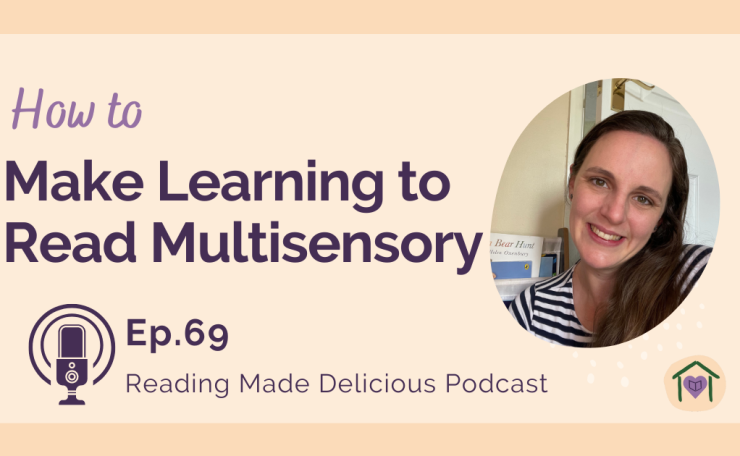How to support your child with reading using visual, audio and kinesthetic ways
Apple Podcasts – Spotify – Amazon Music – Google Podcasts
Let’s explore how to create a multisensory reading experience for your child, making the process engaging and effective, even for the busiest parents. Here’s how you can make learning to read a multisensory adventure!
In this episode about multisensory ways to help your child with learning to read:
Learning to read is a big task for young children, and finding comprehensive resources can be challenging. The concept of multisensory learning has gained traction over the years. While older models suggested people might be visual, auditory, or kinesthetic learners, modern understanding suggests using a combination of these methods is more beneficial. Here’s how to engage all the senses in your child’s reading journey.
Visual Learning Techniques
Visual learning involves the use of imagery and visual tools to aid comprehension. Some ways to incorporate visual learning include:
**Letter Games:** Play “I Spy” games focusing on letters and sounds.
**Visual Aids:** Use magnetic letters and move them around to form words, helping children get used to how letters and words look and feel.
Auditory Learning Techniques
Auditory learning leverages sounds and listening to reinforce understanding. While reading aloud and listening to audiobooks are great strategies, consider creating sound-based games that encourage children to identify and mimic sounds.
Kinesthetic Learning Techniques
Kinesthetic learning, or hands-on learning, can be particularly effective, especially for younger children. Though it can be resource-intensive, the benefits are worth it. Consider the following activities:
Play-Doh Letters:– Have your child form letters and words using Play-Doh. This tactile activity helps reinforce letter shapes and sounds.
Writing in Sand or Paint:- Use different materials like sand or paint to make writing a more engaging experience.
Movement-Based Activities: Integrate physical movement into learning, such as jumping on letter mats or tracing letters with their fingers in the air.
Multisensory Learning at Different Stages
Early Reading Stages
For children just beginning to learn letters and sounds, multisensory activities can make learning more concrete. Use Play-Doh or similar materials for forming letters, and engage in sensory activities like writing in sand or using paint.
Phonics and Blending
When your child moves on to phonics and blending, you can incorporate magnetic letters to help them physically manipulate sounds and form words. Playing phonics games on-the-go, such as during car rides, can help reinforce these skills.
Fluency Building:
For children progressing to reading fluency, consider activities like treasure hunts where they have to read clues, or use real-life books that relate to their experiences. Cooking recipes together can also be a fun and educational way to practice reading for a purposeful, real-life task.
Incorporate multisensory methods to make reading interactive and engaging. Think about visual, auditory, and kinesthetic ways of learning, and remember that it’s about creating a balance that works for your child.
Reading Made Delicious Resources to help support you
- Download the ultimate guide to using recipes for learning to read and get started with helping your child.
- Check out the latest read-to-cook recipes and reading support here
Join our Reading Made Delicious Podcast Community to grow your child’s reading and early learning:
Send me a DM on Instagram. I love chatting with families (and other educators). So send me a message about supporting your child’s reading using multisensory ways.
Enjoying the podcast? Thanks for tuning in!
Tag me @reading_made_delicious on Instagram and tell me what you are listening to! I love seeing what resonates most with our listeners!
I don’t want you to miss a thing! Be the first to know when an episode is available by subscribing to your favourite player here Apple Podcasts – Spotify – Amazon Music – Google Podcasts
If you would like to support the Reading Made Delicious Podcast, it would mean so much to me if you would leave a review on iTunes. By leaving a review, you are helping more families to find this and help support their child’s learning journey.
To leave a review on iTunes, click here and scroll down to ratings and reviews. Click ‘write a review’ and share with me how this podcast is helping you grow your child’s learning.
Ready for more? Listen to these Reading Made Delicious Podcast Episodes next:
- Just 5 minutes of play could help your child’s behaviour at home [Ep 53]
- How can a learning through play approach be so powerful [Ep 51]
Content Disclaimer
The information contained above is provided for information purposes only. The contents of this episode are not intended to amount to advice and you should not rely on any of the contents of this podcast. Professional advice should be obtained before taking or refraining from taking any action as a result of the contents of this podcast. Sarah Travers disclaims all liability and responsibility arising from any reliance placed on any of the contents of this episode.

